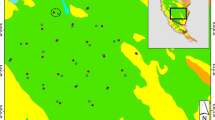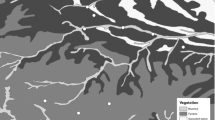Abstract
Monitoring the effectiveness of management activities within reserves is always a complicated task. When the focus of management activities is mammals, it is difficult to monitor their populations in a way that is rapid, effective, and inexpensive. We report on a mammal survey of a reserve in southwest China using remote-trip cameras. We surveyed 329 locations over 2 field seasons in 2002 and 2003. Sixteen species of mammals were detected with these cameras, with four species documented for the first time. After accounting for variation due to slope, aspect, elevation, and habitat type, the distribution of six species was positively associated with the location of conservation stations and/or patrolling routes. Species of medium-sized mammals are excellent candidates for monitoring programs based on these cameras, due to their relative abundance, sufficient size to be detected by the camera units, and sensitivity to human activity. The distribution of mammals relative to management efforts is a relatively rapid means to assess reserve effectiveness. The repeat use of the cameras as part of a monitoring plan should provide a quantifiable measure of reserve effectiveness.



Similar content being viewed by others
References
Atauri J. A., J. V. De Lucio, M. A. Munoz. 2005. A framework for designing ecological monitoring programs for protected areas: a case study of Galachos del Ebro Nature Reserve (Spain). Environ Manage 35:20–33
Carbone E. S., K. Christie, T. Conforti, et al. 2001. The use of photographic rates to estimate densities of tigers and other cryptic mammals. Anim Conserv 4:75–79
Caro T. M. 1999. Conservation monitoring: Estimating mammal densities in woodland habitats. Anim Conserv 2:305–315
Carrillo E., G. Wong, A. D. Cuaron. 2000. Monitoring mammal populations in Costa Rican protected areas under different hunting restrictions. Conserv Biol 14:1580–1591
Ervin J. 2003. Rapid assessment of protected area management effectiveness in four countries. Bioscience 53:833–841
Foresman K. R., D. E. Pearson. 1998. Comparison of proposed survey procedures for detection of forest carnivores. J Wildl Manage 62:1217–1226
Fu B., K. Wang, Y. Lu, et al. 2004. Entangling the complexity of protected area management: The case of Wolong Biosphere reserve, Southwestern China. Environ Manage 33:788–798
Fuller T. K. 1991. Do pellet counts index white-tailed deer numbers and population change? J Wildl Manage 55:393–396
Gaines W. L. 2001. Large carnivore surveys in North Karakorum Mountains, Pakistan. Nat Areas J 21:168–171
Garshelis D. L. 2000. Delusions of habitat evaluation; measuring use, selection and importance. In L. Boitani, T. K. Fuller (eds), Research techniques in animal ecology; controversies and consequences. Columbia University Press, New York pp 111–164
Ge T. 2000. Preliminary study of the behavioral ecology of wild golden monkeys. In The progress of foundation. Tangjaihe Nature Reserve, Qingchuan County, Sichuan, People’s Republic of China (in Chinese with English abstract) pp 165–170
Gibbs J. P. 2000. Monitoring populations. In Boitani L, Fuller TK (eds), Research techniques in animal ecology; controversies and consequences. Columbia University Press, New York, pp 213–252
Green R. E., A. Balmford, P. R. Crane, et al. 2005. A framework for improved monitoring of biodiversity: Responses to the World Summit on Sustainable Development. Conserv Biol 19:56–65
Grigione M. M., P. Burman, V. C. Bleich, et al. 1999. Identifying individual mountain lions Felis concolor by their tracks: Refinement of an innovative technique. Biol Conserv 88:25–32
Hockings M. 2003. Systems for assessing the effectiveness of management in protected areas. Bioscience 53:823–832
Karanth K. U., J. D. Nichols. 1998. Estimation of tiger densities in India using photographic captures and recaptures. Ecology 79:2852–2862
Lindsey P. A., R. Alexander, J. T. Du Toit, et al. 2005. The cost efficiency of wild dog conservation in South Africa. Conserv Biol 19:205–1214
Ma S., X. Ma, W. Shi. 2001. A guide to mammal tracking in China. China Forestry Publishing House. Beijing
Mace G. M., J. E. M. Baillie, S. R. Beissinger, et al. 2001. Assessment and management of species at risk. In M. E. Soule, G. H. Orians (eds), Conservation biology; research priorities for the next decade. Island Press, Washington, DC pp 11–30
MacKensie D. I. 2005. What are the issues with presence–absence data for wildlife managers? J Wildl Manage 69:849–860
Manley P. N., M. D. Schlesinger, J. R. Roth. 2005. A field-based evaluation of a presence–absence protocol for monitoring ecoregional-scale biodiversity. J Wildl Manage 69:950–966
Manley P. N., W. J. Zielinski, M. D. Schlesinger. 2004. Evaluation of a multiple-species approach to monitoring species at the ecoregional scale. Ecol Appl 14:296–310
Margoluis R., N. Salafsky. 1998. Measures of success: Designing, managing and monitoring conservation and development projects. Island Press, Washington, DC
McNeely J. A. 1989. Protected areas and human ecology: How national parks can contribute to sustaining societies of the twenty-first century. In Western D, Pearl M (eds), Conservation for the twenty-first century. Oxford University Press, New York, pp 150–157
Milner-Gulland E. J., H. Resit Akcakaya. 2001. Sustainability indices for exploited populations. Trends Ecol Evol 16:686–691
Moruzzi T. L., T. K. Fuller, R. M. DeGraaf, et al. 2002. Assessing remotely triggered cameras for surveying carnivore distributions. Wildl Soc Bull 30:380–386
Nagendra H., C. Tucker, L. Carlson, J. Southworth, M. Karmacharya, B. Karna. 2004. Monitoring parks by remote sensing: Studies in Nepal and Honduras. Environ Manag 34:748–760
Numata S., T. Okuda, T. Sugimoto, et al. 2005. Camera trapping: a non-invasive approach as an additional tool in the study of mammals in Pasoh Forest Reserve and adjacent fragmented areas in Peninsular Malaysia. Malayan Nature J 57:29–45
Parrish J. D., D. P. Braun, R. S. Unnasch. 2003. Are we conserving what we say we are? Measuring ecological integrity within protected areas. Bioscience 53:851–860
Possingham H. P., S. J. Andelman, B. R. Noon, et al. 2001. Making smart conservation decisions. In M. E. Soule, G. H. Orians (eds), Conservation biology; research priorities for the next decade. Island Press, Washington, DC, pp 225–244
Rao M., Rabinowitz A., S. T. Khaing. 2002. Status review of the protected areas systems in Myanmar, with recommendation for conservation planning. Conserv Biol 16:360–368
Robinson J. G., R. E. Bodmer. 1999. Towards wildlife management in tropical forests. J Wildl Manage 63:1–13
Royle J. A., J. D. Nichols. 2003. Estimating abundance from repeated presence–absence data or point counts. Ecology 84:777–790
Sanderson J. G., M. Trolle. 2005. Monitoring elusive mammals; unattended cameras reveal secret of some of the world’s wildest places. Am Sci 93:148–155
Schaller G. B., Q. Teng, K. G. Johnson, et al. 2000. The feeding ecology of giant pandas and Asiatic black bears in the Tangjaihe Peserve, China. The progress of foundation. Tangjaihe Nature Reserve, Qingchuan County, Sichuan, People’s Republic of China, pp 235–255
Schauster E. R., E. M. Gese, A. M. Kitchen. 2002. An evaluation of survey methods for monitoring swift fox abundance. Wildl Soc Bull 30:464–477
Schwartman S., A. Moreira, D. Nepstad. 2000. Rethinking tropical forest conservation: Perils in parks. Conserv Biol 14:1351–1357
Sheng H., O. Noriyuki, H. Lu. 1999. The mammalian of China. China Forestry Publishing House, Beijing
Stem C., R. Margoluis, N. Salafsky, et al. 2005. Monitoring and evaluation in conservation: A review of trends and approaches. Conserv Biol 19:295–309
Swann D. E., C. A. Haas, D. C. Dalton, et al. 2004. Infrared-triggered cameras for detecting wildlife: An evaluation and review. Wildl Soc Bull 32:357–365
Tangjiahe NRAD (Nature Reserve Administrative Department). 2000. The progress of foundation. Tangjaihe Nature Reserve, Qingchuan County, Sichuan, People’s Republic of China
Tosh C. A., B. Reyers, A. S. van Jaarsveld. 2004. Estimating the abundances of large herbivores in the Kruger National Park using presence–absence data. Anim Conserv 7:55–61
Trolle M., M. Kery. 2003. Estimation of ocelot density in the Pantanal using capture–recapture analysis of camera-trapping data. J Mammal 84:607–614
Weckerly F. W., M. A. Ricca. 2000. Using presence of sign to measure habitats used by Roosevelt elk. Wildl Soc Bull 28:146–153
Wemmer C (ed). 1998. Deer; status survey and conservation action plan. IUCN/SSC Deer Specialist Group. IUCN, Gland, Switzerland
Wemmer C., T. H. Kunz, G. Lundie-Jenkins, et al. 1996. Mammalian Sign. In D. E. Wilson, F. R. Cole, J. D. Nichols, et al. (eds), Measuring and monitoring biological diversity; standard methods for mammals. Smithsonian Institution Press. Washington, DC pp 157–176
White L. J. T. 1994. Biomass of rain forest mammals in the Lope Reserve, Gabon. J Anim Ecol 63:499–512
Acknowledgments
This work was supported by Friend’s of the National Zoo, Peking University, Sichuan Forestry Department, Fuji Film, and China Wildlife Conservation Association. Daniel Guertin performed some of the preliminary analyses. The patrolling staff at Tangjiahe Nature Reserve performed the hard work of moving the cameras. Reviewers substantially improved the quality of the manuscript.
Author information
Authors and Affiliations
Corresponding author
Rights and permissions
About this article
Cite this article
Dajun, W., Sheng, L., McShea, W.J. et al. Use of Remote-Trip Cameras for Wildlife Surveys and Evaluating the Effectiveness of Conservation Activities at a Nature Reserve in Sichuan Province, China. Environmental Management 38, 942–951 (2006). https://doi.org/10.1007/s00267-005-0302-3
Received:
Accepted:
Published:
Issue Date:
DOI: https://doi.org/10.1007/s00267-005-0302-3




